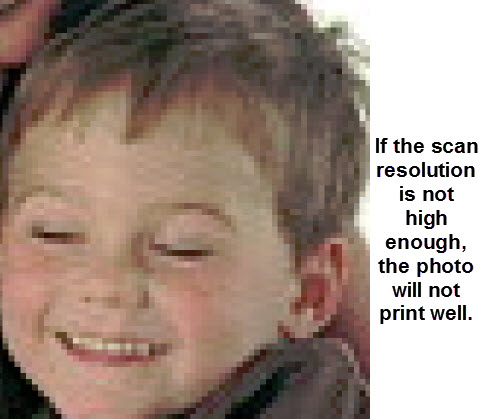When you decide to digitize your photos, there are a few options to consider first. Different types of photo scanners offer unique features which produce different results. It is important to understand them before you drop your pictures off at the Photo Scanning Center so that you get the scan quality that you want.
Using a scanner that is dedicated to scanning photos makes a huge difference. Do not purchase or use a document scanner that you may find at a Staples or other office supplies stores. These are usually used for scanning black and white text documents. A dedicated photo scanner will allow you to capture your photographs in their original detail and vibrant colors and will allow you to chose different scanning resolutions which will affect the overall quality and sharpness of the photo.
Each resolution is appropriate for different situations and intended use. The specific resolution you are using refers to the digitized photo’s DPI (Dots Per Inch). The DPI indicates the amount of pixels found on the digitized photos per inch. The higher the DPI, the more pixels in the image, and resulting in a bigger file size. More pixels give a more detailed image.

These are some of the most common DPI settings. At the low end of resolution and quality is 72 DPI. This resolution is suitable for online viewing. It results in a very small sized photo which is beneficial for sharing online with friends or sending through email but not for printing.

The next step up, 300 DPI, is used when you are printing your photos. Although printing is capable at this level, it still may not be as sharp as you’re hoping for.
600 DPI is also used for printing, but at a much clearer and detailed resolution. This is the standard for printing photos and suitable for enlargement. Photo labs typically charge extra for scanning at resolution because the process takes longer, but it’s worth it. Here at Play It Again Video, 600 is our default scanning resolution and we don’t charge extra for it.
The last commonly used resolution, but far from the maximum is 1,200 DPI. This is usually used for pieces of art made by professional artists. Any type of historic material like an old family document might be scanned at this highly detailed level.
Before you drop off your photos to be scanned, think about the different choices and which resolution fits best with the outcome you are trying to achieve. It is important that you choose at least 300 DPI, but preferably 600 to get a sharp and clear result. The most important thing to find out from the scanning center is that they are using a dedicated photo scanner instead of an auto-feed document scanner.






Speak Your Mind